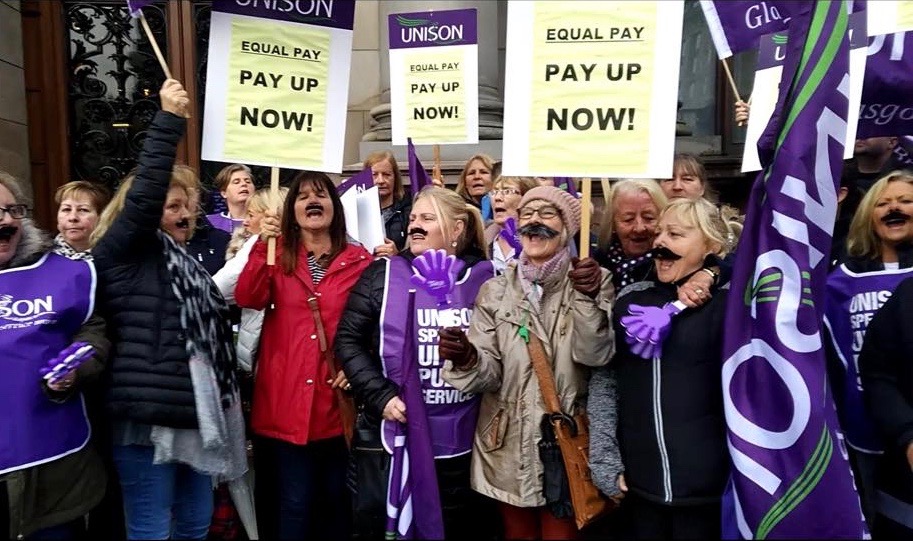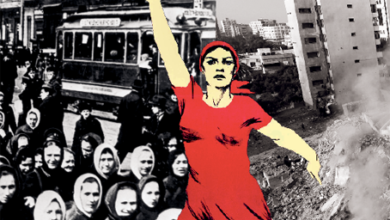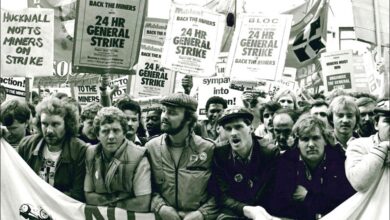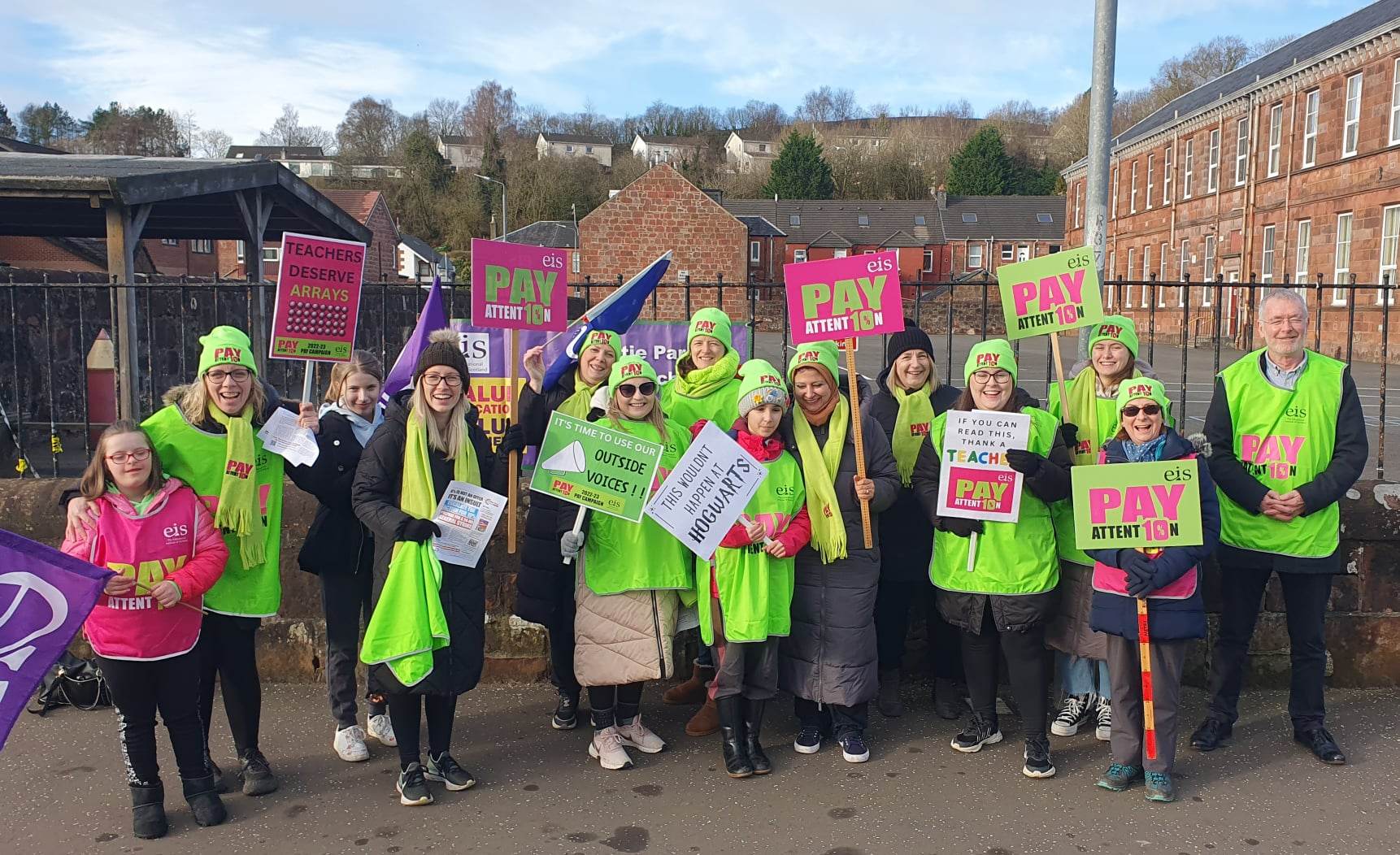Women, the Russian revolution and the collpase of Stalinism
On the 20th anniversary of the fall of the Berlin Wall the world media have been falling over themselves to commemorate events that showed once and for all that capitalism was victorious, that communism, socialism and Marxism were confined to the dustbin of history and the people of Russia and Eastern Europe can now bask in the wealth and freedom that we in the west have ‘enjoyed’ for decades.
What a crushing disappointment the reality of market capitalism has meant for the working class in these countries. Mass unemployment, poverty pay, inequality and war have been the reality for millions of people. Women, in particular, have faced the sharp edge these social and economic ‘reforms’.
Christine Thomas and Sinead Daly
A United Nations Children’s Fund (UNICEF) report, Women in Transition, (September 1999) found that in the countries where data is available, female labour force activity has declined dramatically since 1989. In Russia between1990-95 women lost seven million jobs compared to two million lost by men. Today women make up 72% of those who are unemployed for 12 months or more.
In East Germany between 1989 and 1991 unemployment amongst men increased by 300% but female unemployment soared by 500%. These figures are particularly stark given the previously high levels of economic activity of women.
Women in Russia have also seen a widening in the gender pay gap. In the 1990’s women earned 70% of male earnings (similar to the west), but by the end of the 1990’s they earned just 52% of male earnings and by 2000 this had fallen to just 50% of male earnings. As in Western Europe women workers are concentrated in the public sector and services industries.
The consequences for women are that they are more economically dependent on men. This coupled with the shortages in housing and the lack of a social welfare system has meant that thousands of women have no choice but to remain in an abusive relationship or a relationship which has ended; many are even forced to share a house with their ex-partner after they divorce because they have nowhere else to go.
Domestic Violence
Domestic abuse in Russia and Eastern Europe has remained very high. In Russia women are 6 times more likely to be killed by partners than women in Western Europe. In 7 regions of Russia 41% of women have been beaten by their husband at least once. In Poland, there is evidence to show that violence has increased in prevalence since the return to capitalism, not least because of the increasing grip that the Catholic Church has over society which has reinforced the unit of the family, a man, dependent wife and dependent children.
“Often, women see divorce as their only option in a violent marriage. Poland’s Divorce laws, however, are designed to preserve the family unit. Women have difficulty leaving their abusers and obtaining satisfactory divorce settlements. Even when they are successful in obtaining a divorce, women often must continue to share a home with their abusive husbands because of the shortage of affordable housing in Poland.”
The report continues:“A senior gynaecologist in Warsaw noted that, “[Poland’s] transition is bad for violence. Violence against women has increased since the transition. Many people are unemployed, it is unsafe on the streets . . . . [Before], all people had some work. Now, we have violence, unemployment [and] . . . people are experiencing social degradation that they did not experience before. Democracy means more violence and more unemployment.” He added that, “changes to the Polish education and political system[s] have been causing an increase in aggression towards women. This change has come about in part [because] the general profile and scheme of family has changed. In addition, the general economic situation of the family has changed, causing the increase in aggression.” (Domestic Violence in Poland 2002)
Sex Trafficking and Prostitution
One of the most shameful and disturbing outcomes of the return to capitalism has been the explosion in the number of women being bought and sold for use in the sex industry across the world. If you’re a woman, young, poor and socially excluded from Eastern Europe then you are at increased risk of being forced into prostitution. It is estimated that between 400,000 and 2 million women, mostly from the Ukraine and other Eastern European countries are trafficked for use in the sex industry in Western Europe. This global business is now worth between $7 and $12 billion dollars a year!
The recent World Cup in Germany graphically illustrated the contempt that the capitalist system holds for women’s bodies. A huge 3,000 square meter tent was allowed to be built for the use as a brothel in the heart of Berlin. It allowed for up to 650 men to be ‘accommodated’ at any one time!
The promise of Liberation
UNICEF state that the transition is ‘building upon rather than levelling existing inequalities’. There were many ‘positive legacies’ from the former Stalinist regimes, they argue, in the form of healthcare, education, paid maternity leave, child allowances and childcare, but in reality only a thin ‘veneer of equality’.
Yet, according to official Stalinist propaganda, women in the former Soviet Union and Eastern Europe had achieved liberation. Equality was legally enshrined and women formally enjoyed the same economic and social rights as men. In East Germany 91% of women were economically active. In most countries 50% of workers were female, comprising a highly educated sector of the workforce.
However legal rights and participation in the labour market don’t add up to liberation, as many women in the capitalist West are increasingly discovering. Genuine liberation presupposes a total economic and cultural transformation in society.
In 1917 the Bolshevik revolution laid what was hoped would be the basis for such a transformation. Women’s liberation formed a key component of the Bolsheviks’ programme. The revolution ushered in a series of radical legal and civil rights which went far beyond those achieved by women in the more economically developed capitalist West at that time. Marriage became a simple civil procedure. Divorce was granted if requested by either partner. Every woman obtained the right to legal, free abortion. Homosexuality was legalised.
But the Bolsheviks recognised that formal equality was not enough. If women were to become economically independent, play an equal role in society, and form free and equitable personal relationships, they had to be relieved of their domestic burdens within the family. Lenin referred to the ‘domestic slavery’, the ‘stultifying’, ‘degrading’ and ‘crushing’ drudgery, which was the lot of the majority of women, especially within the peasant household. Measures were taken to free women from this drudgery by socialising household work through the provision of public restaurants and communal laundries. Childbearing and childrearing was to be eased through public crèches, nurseries and maternity benefits.
At the same time a conscious campaign was waged to change the backward and reactionary attitudes towards women which were deeply engrained within society, underpinning the subordinate position of women within the family and the unequal division of ‘domestic labour’. The 1919 programme of the Communist Party stated that “the party’s task at the present moment is primarily work in the realm of ideas and education so as to destroy utterly all traces of the former inequality or prejudices”.
The Bolsheviks held up a vision of real liberation, where all aspects of women’s lives would be transformed. New economic and social relations, based on equality and co-operation, would give rise to new attitudes, ideas and personal relations. In her writings and speeches, Alexandra Kollantai, a prominent Bolshevik leader and the Commissar for Social Welfare in the first soviet government, explored the link between economic and social change and sexuality and personal relations. The revolution itself unleashed enormous creative forces. Young revolutionaries began to question traditional household and personal arrangements, experimenting with new ways of living and relating to each other.
However these determined efforts at transforming the lives of women and society generally were constrained by cultural and material backwardness. Russia, a predominantly peasant country, endured the ravages of the first world war, armed intervention against the revolution by 21 imperialist armies, and a brutal civil war. Forging new social and personal relations against the backdrop of economic devastation, war and famine became an overwhelming task.
This same economic backwardness, which could only be overcome with the spread of the revolution to more advanced countries, gave rise to a bureaucratic elite increasingly concerned with maintaining its own privileged position ‘administering’ society. While the nationalised planned economy was preserved, the political and social gains of the revolution came under attack. The ‘revolution in thinking’ which was required to liberate women could not be tolerated, when all critical thought represented a potential challenge to the rule of the new elite. Increasingly the needs and aspirations of women and workers generally were subordinated to the interests of the ruling bureaucracy.
Stalinist Reaction
In 1928, to thwart the threat of capitalist restoration, Stalin, the leader of the new ruling bureaucracy, embarked on a programme of forced industrialization and collectivisation of the land. This necessitated a rapid increase in the labour force, including women workers. Eighty-two per cent of workers entering the labour market between 1922 and 1937 were female. In 1922 women comprised 22% of the workforce; by 1932 this figure had grown to 32%.
Working outside the home increases women’s economic independence and raises their confidence and consciousness as women and as workers. It therefore represents an important step towards emancipation. For the Stalinist bureaucracy however, the forced entry of women into the workforce was a matter of economic expediency not a route to liberation. Moreover, it was accompanied by a conscious policy to shore up and bolster the family as a social and economic unit. While the Bolsheviks strove to overcome the economic and social inequalities arising from women’s subordinate role within the family, the bureaucratic elite perpetuated those inequalities in order to maintain their own material privileges and prestige. The family represented an essential means of social control, a place where young people in particular could be disciplined to accept the power and authority of the bureaucracy.
Material and cultural poverty had already placed limitations on the Bolshevik goal of emancipating women. Women had gained the legal right to divorce but those who were unable to find work and earn enough to live independently either remained in unsatisfactory relationships or risked destitution. Faced with the reality of poor quality and under-resourced communal facilities, many women returned to their traditional domestic sphere. Now, as the bureaucracy tightened its parasitic grip on society, it consciously turned those constraints towards its own interests. Communal facilities such as laundries and restaurants were deliberately run down, offloading the burden for providing those services onto the family, and reinforcing the unequal division of labour within it.
In the process of reinforcing the private family unit, most of the gains which the Bolshevik revolution had granted women were rolled back. Marriage procedures were tightened and access to divorce became increasingly difficult for all but the very wealthy. Abortion was made illegal in most cases, forcing women to risk their health and lives through illegal procurement. By 1938-39, 12.7% of every 100,000 deaths amongst urban women were caused by illegal abortions. At the same time Stalinist propaganda extolled the joys of motherhood. Through a combination of exhortation and coercion women were urged to fulfil their glorious duty to reproduce the next generation of ‘socialist’ workers but they were also expected to play a full role in the production process.
Women’s double burden
The position of women in the Soviet Union and the Stalinist regimes which emerged in Eastern Europe after the Second World War, developed from the period when the bureaucracy consolidated its power. Women were defined in law as naturally having a dual role in society, both productive and reproductive. Social policy reinforced these roles but the emphasis shifted depending on the needs of the bureaucracy.
So in 1955 for example, abortion was legalised in the Soviet Union, followed closely by Poland and Czechoslovakia. With contraception almost non-existent, it was not unusual for women in the Soviet Union to endure multiple abortions, some as many as 14, a practice which still continues today in parts of Russia. But abortion facilities did not feature in the economic priorities of the bureaucracy. Conditions were barbaric, with production line abortions carried out without anaesthetic or adequate hygiene.
Then, in the 1960s, fears of declining birth rates prompted abortion restrictions in several countries. In Romania in 1967 abortion was made completely illegal unless women already had four children. In the 1980s abortion was liberalised once more in many countries (but not Romania). Prior to the fall of the Wall, women in East Germany in particular, enjoyed relatively good access to contraception and abortion facilities. The compromise abortion law passed following reunification, which includes compulsory counselling, marks a significant attack on their reproductive rights.
Abortion Laws in Poland are very restrictive. Women can only get an abortion when there is a threat to the life or health of the mother. However, the reality is that many women, even when there has been a threat to their life and health have been unable to find a doctor to perform an abortion, such is the fear that exists. There have been several high profile cases of women suing the state, and winning, because of this infringement of their human rights
Pro-natalist policies such as extended childcare leave and improved maternity and child benefits, were introduced to enable women to combine their dual role as mothers and workers. These were motivated primarily by demographic considerations, not the needs of women themselves. Such policies reinforced gender divisions. In Poland for example, paid leave to care for sick children was only available to women. In East Germany a monthly ‘household day’ to catch up on domestic duties remained the preserve of women. However these represented real material gains for women, all of which have come under sustained attack in the transition to capitalism.
This is especially true in the case of socialised childcare. The quality and quantity of childcare varied considerably between the Stalinist countries. While in East Germany the majority of pre-school children could secure a place in a public nursery, provision in Poland was extremely limited.
In Czechoslovakia at the beginning of the 1970s only 10% of under-threes were in state nurseries. In the Soviet Union, by the end of the 1970s, places existed for only 13 million out of 35 million pre-schoolers. When the lid was lifted on conditions in the Soviet Union during the Glasnost era of the 1980s, women revealed the inadequacies of existing childcare provision. Often kindergartens were desperately understaffed and overcrowded, ignoring the individual needs of children. Nevertheless, despite all its shortcomings, the loss of state provided childcare has dealt a devastating blow to working women.
Often benefits such as housing, healthcare and childcare were workplace linked. Becoming unemployed has therefore meant losing much more than a job. With privatisation and deregulation, childcare provision has been slashed or become prohibitively expensive for the majority of women, forcing them to give up work. Some have decided to not have children at all in order to improve their chances of finding or keeping a job. Across the former Stalinist countries fertility rates have fallen by 40-50%. For those who lose their jobs, lack of childcare has made getting back into the workforce extremely difficult.
Women within the family were expected to compensate for the inadequacies in social services created by a distorted and bureaucratised planned economy. A survey carried out in East Germany in 1985 revealed that women were burdened with 60% of domestic labour. In Poland and Hungary the figure was nearer 80%. According to studies carried out in both these countries in 1984, women spent six hours a day on household chores and childcare.
Since almost all women worked full-time, those not forming part of the bureaucratic elite were continually weighed down by their enormous double burden. Shortages of food and consumer goods exacerbated the situation. The following description of everyday life for women in northern Russia, published in 1984, summarises the situation:
“Tired after their workday, they hurry home to childcare centres. Bowed with the weight of grocery bags, they drag their children behind them. In a terrible crush of people, they wedge themselves into overcrowded public buses, elbowing people aside and pushing their way through to an empty seat, if there is one. At last, they reach home. Here new cares await them: dinner must be prepared and the husband and children must be fed. The laundry and housecleaning still await because, for a working woman, there is no other time for these chores. She cannot depend on her husband for anything. The next morning, these women, with glum, blank expressions, take their children to school or childcare centres and hurry to work. They perform their jobs mechanically, without inspiration, without enthusiasm”.
Since this was the daily reality for millions of women, it would hardly be surprising that some greeted redundancy and the chance to spend time with their children with relief. Being a Stalinist Superwoman was exhausting and draining. However this has not been the attitude of the majority of women.
In a poll carried out in East Germany in 1990 amongst women aged 16-60, only 3% described being a housewife as their ideal (compared to 25% in West Germany). 65% said that they would work, even if they didn’t need the money. For these women work represents an important part of their identity and self-esteem.
Many women, who may have initially welcomed a respite from their double burden, are finding it impossible to survive economically and equally impossible to get back into the workforce. The reality of capitalism today brings little reprieve:
“If you are 40, the chances are you are bringing up small children — paying kindergarten fees — and looking after ageing parents whose pensions are now hopelessly inadequate. OK, it was always like this, under the communists and today. The difference is that the State helped to ease this family crisis a bit. Schools were more flexible and did not cost anything; pensions were adequate.” She draws on her second cigarette in a ten-minute chat. “Communism was going nowhere but it gave a kind of order to women’s lives, and confidence. What do we have now? We have to be good workers, good mothers, good daughters, good lovers — we are bombarded by these demands and it is driving us crazy.” (Was 1989 a revolution strictly for the boys?, The Times, Nov 3rd 2009)
Neither Stalinism nor capitalism
In 2007, the tremendous battle of Polish nurses for better wages is a shining example to other low paid women workers around the world of how to organise. Tens of thousands of nurses went on strike for a 30% pay rise so they could earn just £499 a month (Polish nurses earned an average of 700 zloty a month – the average monthly wage in Poland is 2000 zloty). Over a thousand nurses set up a “White Village” of tents outside the prime minister’s office, some went on hunger strike and demonstrations were attacked by the police, some nurses were hospitalised. They received massive support from the public and trade unionists, in particular the miners and public sector workers.
These examples and many others show the way forward. With the current economic recession women will again face the hard edge of capitalism and will have little option but to fight. With the complete capitulation of the social democratic parties to market capitalism, there is an urgent need for women to organise a socialist political alternative to market capitalism.
Stalinism betrayed the hopes and aspirations of women for a liberated future. But capitalist restoration has dealt them a further blow. Incredibly, having catalogued the inequality and disadvantages which women are suffering under capitalism, UNICEF still concludes that women “have much to gain from the transition” to the market as its ‘principles’, “the search for expression of diversity, genuine political representation, economic development and the expansion of choice”, are the same as those “that drive the movement for women’s equality”.
But these principles are completely incapable of being realised on the basis of a market economy in global turmoil. Under capitalism, a future of continuing economic and social oppression awaits the majority of women in the former Soviet Union and Eastern Europe.
A new revolution is needed to bring about the far-reaching economic, social and cultural transformation which economic backwardness and isolation prevented the Bolsheviks from achieving. This will not be an easy task. The depth and intensity of the crisis unleashed by capitalist restoration, has deeply affected social consciousness. The energies of most working class people and women in particular, are directed towards daily survival.
However, attacks on economic and social conditions have not been completely uncontested. Workers, including women, have taken strike action to defend jobs and working conditions.
Workers have the difficult task of building new organisations to represent their interests and wage a struggle to change society. As part of this process, women will inevitably become organised and fight for their rights as workers and as women. Through struggle they will become increasingly aware that a democratic socialist revolution, within the context of international revolutionary change, is the only route to genuine liberation.



